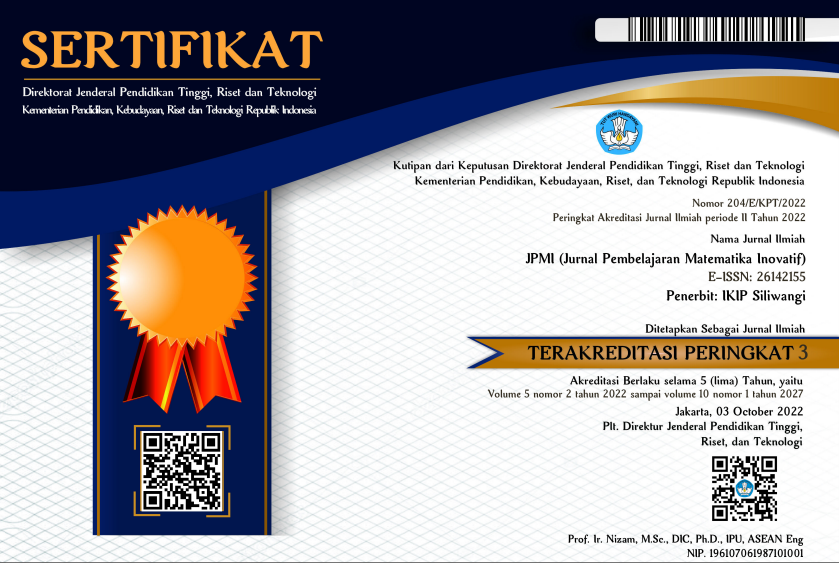Karakteristik kemampuan berpikir kreatif matematis siswa kelas VIII di Kabupaten Bandung Barat
DOI:
https://doi.org/10.22460/jpmi.v6i6.17196Keywords:
Mathematic Creative Thinking Ability, SPLDVAbstract
Being able to think creatively is crucial for kids since creativity is required to address difficulties. The purpose of this research was to find out the characteristics of creative thinking ability of high school students in relation to a two-variable linear equation system. This study was conducted in a high school in West Bandung district, and one class, namely class VIII B, with 23 students participated in the study. The method used in this study is a descriptive qualitative method. This study used test instruments and non-test instruments in the form of questions and interviews. The effects confirmed that students have been able to resolve questions based on only two indicators of creative thinking ability, ie. fluency 55.32% and flexibility 68%, and students could not solve tasks based on news indicators one 14,44%. Based on the results of the interviews, this resulted in students who generally could not work and solve questions with their own answers or thoughts, but only procedurally followed the SPLDV problem solving method.
References
Candra, O., Dupri, Gazali, N., Khairullazi, & Oktari, A. (2019). Community education engagement journal. Community Education Engagement Journal, 1(1), 58–66. https://journal.uir.ac.id/index.php/ecej
Chandra, S. dan N. (2018). Deskripsi kemampuan berpikir kreatif siswa dalam menyelesaikan soal sistem persamaan linear dua variabel (SPLDV) ditinjau dari kemampuan awal pada kelas IX SMP Negeri 5 Makassar. 2, 66–77. https://doi.org/https://science.e-journal.my.id/
Harriman. (2017). Berfikir kreatif. Journal of Chemical Information and Modeling, 53(9), 1689–1699. https://doi.org/https://doi.org/10.31004/sicedu.v1i2.60
Indahsari, A. T., & Fitrianna, A. Y. (2019). Analisis kemampuan pemecahan masalah siswa kelas X dalam menyelesaikan SPLDV. JPMI (Jurnal Pembelajaran Matematika Inovatif), 2(2), 77-86. https://doi.org/10.22460/jpmi.v2i2.p77-86
Marliana, H. (2015). Hasil belajar matematika siswa kelas XI. Gastronomía Ecuatoriana y Turismo Local., 1(69), 8–25. https://repository.stkippacitan.ac.id/id/eprint/502/8/Rina Sulistiyowati_Bab Ii_Pm2021.Pdf
Pratiwi, I., Yulianti, D., & Fitrianna, A. Y. (2018). Kemampuan Berpikir Kreatif Matematik Siswa MTs Ditinjau Dari Kemampuan Resiliensi Matematik Siswa. JPMI (Jurnal Pembelajaran Matematika Inovatif), 1(2), 171-184.http://dx.doi.org/10.22460/jpmi.v1i2.p171-184
Rosmala, A. (2021). Model-model pembelajaran matematika. Bumi Aksara. https://books.google.co.id/
Ruhama, M. A. H., Yasin, N., & La Nani, K. (2020). Analisis kemampuan berpikir logis matematis siswa pada materi sistem persamaan linear dua variabel. Jurnal Magister Pendidikan Matematika (Jumadika), 2(2), 81–86. https://doi.org/10.30598/jumadikavol2iss2year2020page81-86
Sari, R. A., & Untarti, R. (2021). Kemampuan berpikir kreatif matematis dan resiliensi matematis. Mandalika Mathematics and Education Journal, 3(1), 30-39. http://dx.doi.org/10.29303/jm.v3i1.2577
Siagian, M. D. (2016). Kemampuan koneksi matematik dalam pembelajaran matematika. MES: Journal of Matematics Education and Science2, 2(1), 58–67. https://jurnal.uisu.ac.id/index.php/mesuisu/article/view/117
Siswono, T. Y. E. (2018). Mendorong berpikir kreatif siswa melalui pengajuan masalah. Konferensi Nasional Matematika XII, 2, 74–87. https://d1wqtxts1xzle7.cloudfront.net/
Sudarma, M. (2016). Mengembangkan keterampilan berpikir kreatif. http://opac.fkip.untirta.ac.id/
Sulfaidah, N., Bahar, E. E., Studi, P., Matematika, P., & Makassar, U. M. (2022). Menyelesaikan soal sistem persamaan linear dua variabel ( SPLDV ) Pada Kelas IX SMP. 2(2), 66–77. https://doi.org/https://doi.org/10.30605/27458326-98
Suparman, T., & Zanthy, L. (2019). Analisis kemampuan beripikir kreatif matematis siswa SMP. Journal on Education, 1(2), 503-508. https://doi.org/10.31004/joe.v1i2.104
Syahara, M. U., & Astutik, E. P. (2021). Analisis berpikir kreatif siswa dalam menyelesaikan masalah SPLDV ditinjau dari kemampuan matematika. Mosharafa: Jurnal Pendidikan Matematika, 10(2), 201–212. https://doi.org/10.31980/mosharafa.v10i2.892
Downloads
Published
Issue
Section
License
Copyright (c) 2024 JPMI (Jurnal Pembelajaran Matematika Inovatif)

This work is licensed under a Creative Commons Attribution-ShareAlike 4.0 International License.
The author is responsible for acquiring the permission(s) to reproduce any copyrighted figures, tables, data, or text that are being used in the submitted paper. Authors should note that text quotations of more than 250 words from a published or copyrighted work will require grant of permission from the original publisher to reprint. The written permission letter(s) must be submitted together with the manuscript.
















